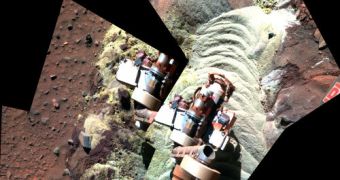It's now or never for NASA's Mars Exploration Rover (MER) Spirit, say mission managers at the Jet Propulsion Laboratory (JPL), in Pasadena, California. The Martian spring is in full swing, and, if the robot is ever to recover, now should be the time.
The last communications NASA had with Spirit were on March 22, 2010, as winter was setting in on the Red Planet. The amount of sunlight available daily for the robot dwindled considerably at that time, and so it entered a protective safe mode.
That March 22 date also represented sol 2210 of the rover's mission. A sol is a Martian day, and it has a little over 24 hours. Now reaching sol 2941, experts are beginning to wonder whether Spirit will ever recover.
This is its fourth winter on our neighboring planet, although its mission, and that of its twin rover Opportunity, was supposed to last for only three months. The machines proved to be very resilient, and so their mission has now entered its seventh year.
Spirit celebrated six complete years of mission a few days ago, whereas Opportunity will turn 7 on January 24. Unlike its twin, the latter does not need to stop during the winter, as it is located at a latitude where sufficient sunlight is available around the year.
On the other hand, Spirit has had it pretty rough the past year, as evidenced by the fact that it's currently trapped in a patch of loose sand called Troy, at an inclination that further reduces the amount of sunlight it receives, and on the slope of a hill that is oriented away from the Sun.
After about nine months of maneuvers and various attempts to getting Spirit out of Troy, NASA and JPL experts decided to convert the rover into a stationary science platform, sort of like a lander.
Now, in order to enjoy the full functionality of the new platform, they need to revive it. For this purpose, they are using the refurbished Deep Space Network (DSN) antenna, which is now more efficient than ever before.
The Mars Reconnaissance Orbiter (MRO) and the Mars Odyssey are also being used to scan the planet for any radio signals, no matter how weak. If Spirit emits something, NASA will hear it.
But the American space agency is also taking into account the possibility of a mission-clock fault. For this reason, it is using a so-called “Sweep & Beep” paging strategy, SpaceRef reports.
This basically means pinging Spirit with signals, so as to stimulate it into restoring its power. These efforts can be conducted now because experts believe there is sufficient sunlight available at Troy to restore the rover's power.

 14 DAY TRIAL //
14 DAY TRIAL //